Certification
-
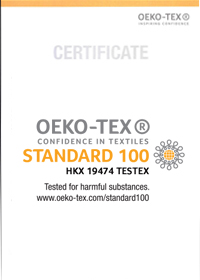
The Oeko-Tex® Standard 100
The Oeko-Tex® Standard 100 is a globally uniform testing and certification system for textile raw materials, intermediate and final products at all stages of production.
The certification confirms compliance with laws that control or prohibit certain substances and chemicals (please refer to Oeko-Tex® website for list of requirements).
The Oeko-Tex® certification process is managed by Oeko-Tex® Association, a group of 15 well-known textile research and test institutes in Europe and Japan, with representative agencies and offices in over 50 countries worldwide.
Fastening products bearing Oeko-Tex® Standard 100 certification, among others:
- Have been tested for the release of heavy metals under artificial perspiration conditions.
- Have been tested for pesticides and chlorinated phenols.
- Are free from formaldehyde (or contain only trace amounts significantly lower than the required legal limits).
Textile products considered for this standard are broken into four categories based on the intended use.
For instance, textile products for babies and toddlers (Product Class I) have to meet the highest requirements. -
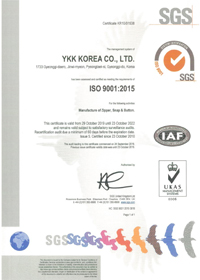
ISO 9001:2015(Quality management systems)
ISO 9001:2015 provides standardized requirements for a best in class quality management system, regardless of what the organization does or its size.
ISO 9001:2015 sets out the requirements a best in class quality system must meet, without specifying how they should be met for any particular organization. -
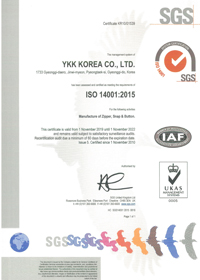
ISO 14001:2015(Environment management systems)
The ISO 14000 family addresses various aspects of environmental management. ISO 14001:2015 provides the requirements for environmental management systems (EMS). An EMS that meets the ISO 14001:2015 requirements provides management tools necessary to:
- identify and control the environmental impact of its activities, products or services;
- continually improve environmental performance; and
- implement a systematic approach to setting environmental objectives and targets, achieving those targets and demonstrating that those targets have been achieved. -
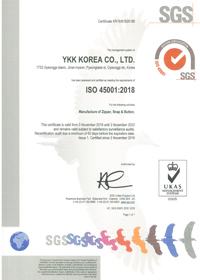
ISO 45001:2018(Occupational health and safety management systems)
An Occupational Safety and Health Management System (OSHMS) promotes a safe and healthy working environment by providing a framework for managers to consistently identify and control health and safety risks, reduce the potential for accidents, aid legal compliance and improve overall performance.
ISO 45001 is the internationally recognized assessment specification for OSHMS’s. It was developed by leading trade, international standards and certification groups. Main issues addressed by ISO 45001 are (a) hazard identification, (b) risk assessment, (c) risk control, (d) ISO 45001 management programs, (e) training awareness and competence and (f) performance measuring, monitoring and improvement. -
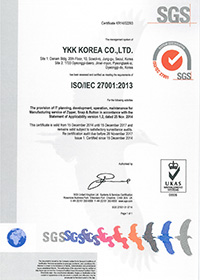
ISO/IEC 27001:2013
ISO/IEC 27001:2013 is an international standard and certification for information security management system established by the International Organization for Standardization (ISO).
YKK KOREA is continuing the information security management system that can respond quickly to changes in the external environment such as increased such information leakage, strengthening the domestic legal regulation and needs for level of international protection
Including the privacy policy, information security such as physical security, intellectual property management, privacy laws, Information and Communication Network Act are under a rigorous screening every year in ISO.
- The protection of information of customers, offering safe services and improving the credibility
- Standardization of management system for protecting information
- Danger evaluation and establishment of countermeasure
- Reinforcement and improvement of security control
- Expansion of recognitions for protecting own information in the company

